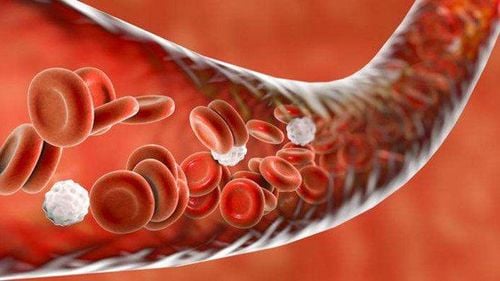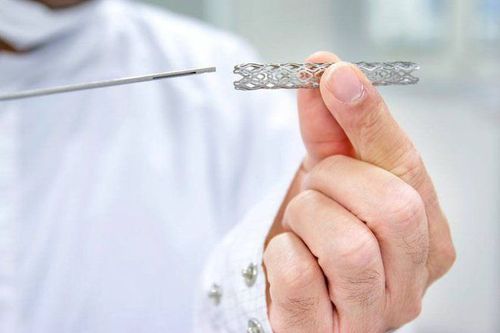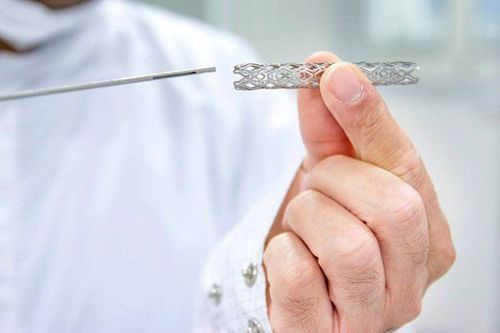This is an automatically translated article.
The article was professionally consulted by Specialist Doctor II Nguyen Quoc Viet - Department of Medical Examination & Internal Medicine - Vinmec Danang International General Hospital. The doctor has more than 20 years of experience in the examination and treatment of cardiovascular diseases and Interventional Cardiology.1. What is a myocardial infarction?
Coronary artery is a network of blood supply to the entire heart muscle, as we age, some coronary arteries will become atherosclerotic. Atherosclerotic coronary artery disease can cause rupture of the artery wall, attracting platelets to attach, causing blood clots inside the coronary artery wall. This condition leads to coronary artery occlusion, also known as myocardial infarction.In some cases, atherosclerotic plaques will narrow the blood vessels, causing obstruction to the blood flow to the heart. This leads to a lack of blood flow to the heart tissues causing chest pain.

2. Why should stents be placed in myocardial infarction?
There are 2 main reasons for doctors to appoint patients to have stents for myocardial infarction as follows:First, when a myocardial infarction occurs, it means that the coronary artery is completely blocked. artery. Second, large atherosclerotic plaques significantly impede coronary outflow and pose a risk of coronary outflow obstruction. In these two cases, coronary stenting will help reopen the blocked flow or re-establish the flow to normal. However, stents can cause thrombus formation within the stent lumen if not treated properly. This is a dangerous complication that can be fatal for the patient.
3. Who should not have a stent placed in a myocardial infarction?
The following subjects are not prescribed by a doctor to place a stent in a heart attack to ensure health and avoid possible complications:Coronary vessels with the following injuries should not have stents: diffuse severe damage, distal lesions, damage to many coronary bodies,... During the intervention of blocked coronary arteries, the risk of death is very high. Patients with bleeding disorders such as coagulopathy or low platelet count. Patients do not comply before and after treatment. The patient had the phenomenon of re-stenosis in many places after the intervention.

4. Stent procedure in myocardial infarction
The patient should first be thoroughly explained about the stenting method, including information such as post-operative risks. Accordingly, the doctor will conduct an examination of the patient to check whether the conditions for the procedure are satisfied. If in one of the cases listed above, stenting should not be performed. Prior to stenting, the patient was given antiplatelet medication.The procedure to perform the procedure is as follows:
Step 1: Open the way into the blood vessel
Disinfect the site that opens the way into the blood. Enter the blood through the femoral or radial artery. Step 2: Place interventional catheter
After selective coronary angiography determine the location that needs intervention. Place interventional catheter into coronary artery. Connect the pressure measuring line to the interventional catheter, Step 3: Coronary intervention
The doctor conducts balloon angioplasty to widen the lumen of the lesion site. Place a stent to prevent coronary artery narrowing after balloon angioplasty. Check that the stent has expanded well. After stenting is complete, coronary angiography should be taken to ensure no complications occur. The last step is to remove the lead from the coronary artery.
5. Patient care after stenting in myocardial infarction
After stenting in myocardial infarction Nurses need to monitor the following factors every half hour to ensure the patient's condition:Pulse, blood pressure, monitor for signs of hypovolemic shock. Observe the thigh area performing surgery for signs of bleeding or hematoma. Check the dorsal pulse, color and temperature of the skin of the leg at the puncture site to avoid limb ischemia.

6. Possible complications after stenting
Some complications that may occur after stenting are as follows:Arrhythmia, bleeding. Pericardial hemopericardium due to rupture, rupture or perforation of the coronary artery. Re-narrowing of the arterial lumen. Radial occlusion, femoral occlusion, cerebral occlusion. Aortic dissection is caused by the arterial wall. Myocardial infarction after the procedure. Acute renal failure due to the influence of contrast agents. Minor surgical site infection, however, is rare. Stent placement in myocardial infarction is a technique that requires a high level of experience of the doctor and the perfect coordination of the patient. In addition, patients should pay attention to the location of the postoperative procedure to avoid unfortunate cases.
Please dial HOTLINE for more information or register for an appointment HERE. Download MyVinmec app to make appointments faster and to manage your bookings easily.














